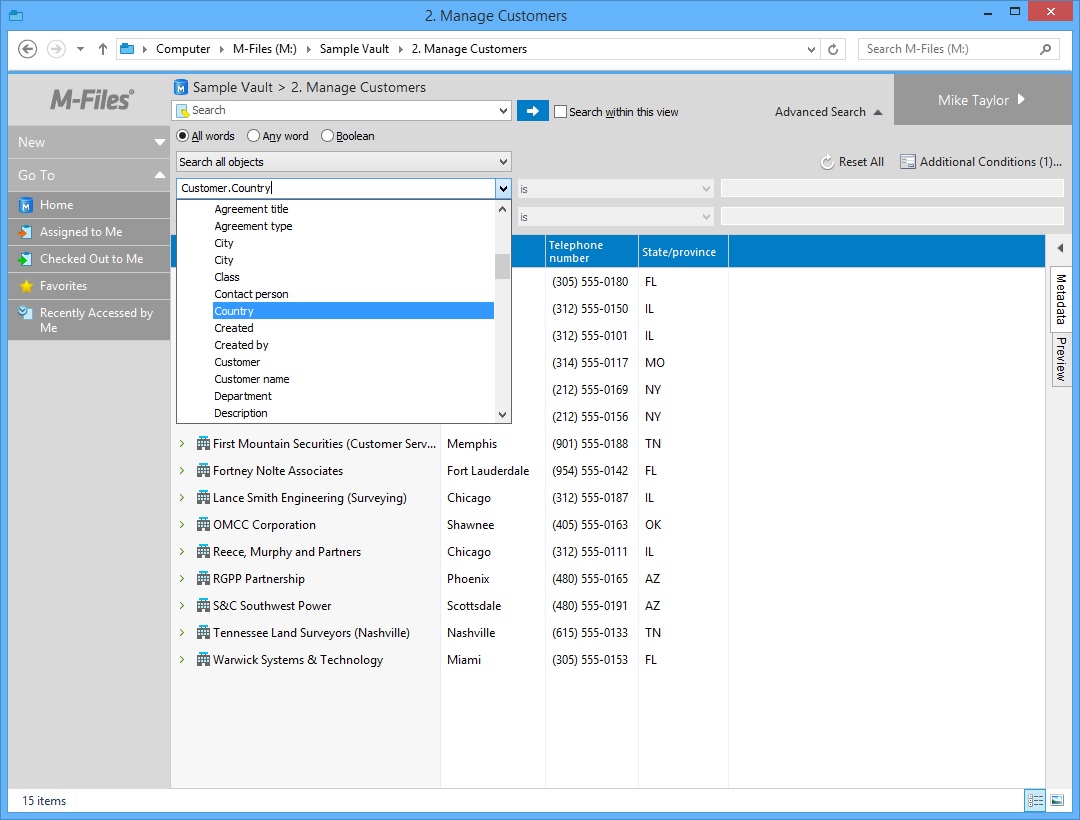With the advanced search, you can specify more specific search criteria for the document or object you are looking for. The more search criteria you use in the advanced search, the more likely you are to find the exact object you want. This way, you can prevent the search from returning too many results.
Advanced quick search
Quick searches can be targeted by search type.
Search types of the advanced quick search
All words |
Objects found contain all specified search words. |
Any word |
The search will return all objects that contain at least one of the specified search words. |
Boolean |
The search allows you to use more specific search phrases and different operators. |
You can use different expressions to find documents and objects that strictly meet your search criteria. The table below lists a few of the wide range of search features provided by M-Files.
Operator |
Description |
Quotation marks: "phrase" |
Enclose the search words in double quotation marks to find objects where the words appear adjacent to each other. Example search: "functional specification" |
AND (Boolean search only) |
The AND operator combines two search terms. Documents found contain both terms. Example search: functional AND specification |
OR (Boolean search only) |
The OR operator retrieves all documents which contain at least one of the terms entered. Example search: agenda OR minutes |
( ) (Boolean search only) |
Brackets are used to group search terms together. Example search: (agenda OR minutes) AND market* This search returns all objects which contain the word "agenda" or "minutes" and which also contain a word or words beginning with "market". |
Advanced search
Each object has property values that can be used to search for documents in a precise manner. The value of the property Project can be for instance Hospital Expansion (Florida). If you perform an advanced search with these values, the search returns all the documents the Project property of which contains the value Hospital Expansion (Florida). You can also restrict the search to a specific object type, such as customers or contact persons.

Advanced search features.
Subordination of search criteria
You can easily specify search criteria by utilizing their subordination, so the options shown in the lists are filtered on the basis of other list choices. For example, if you have selected a certain workflow as the search criterion, the state options are filtered in such a way that only the states related to your selected workflow are visible and selectable. Corresponding filtering will be performed automatically for other interdependent value lists as well. For example, contact persons are filtered by customer if these value lists have a hierarchical relationship.
Subordinate search criteria can be used with the "is" operator. In additional conditions, the operator "one of" can also be used.
Indirect searches
You can specify search criteria also by means of property relationships, which means that the object itself need not have the property in question. Instead, the property selected as the search criterion is in this case the property of a related object.
By using indirect search, you can, for example, find agreements related to a specific country; even if the Country property has not been defined for the actual agreement, it is enough if it can be found via a customer associated with the agreement. In this case, the search criterion is specified as "Customer.Country" combination.
You can specify these indirect search properties by clicking the plus-sign button in the list and then selecting the property of a related object to be used as the search criterion. In the example below, Customer was selected from the list first, and then the customer's Country property, which resulted in the search criterion with a period, "Customer.Country," being displayed in the search field.
By using additional conditions, you can create three-level indirect search criteria.

Indirect search criteria.